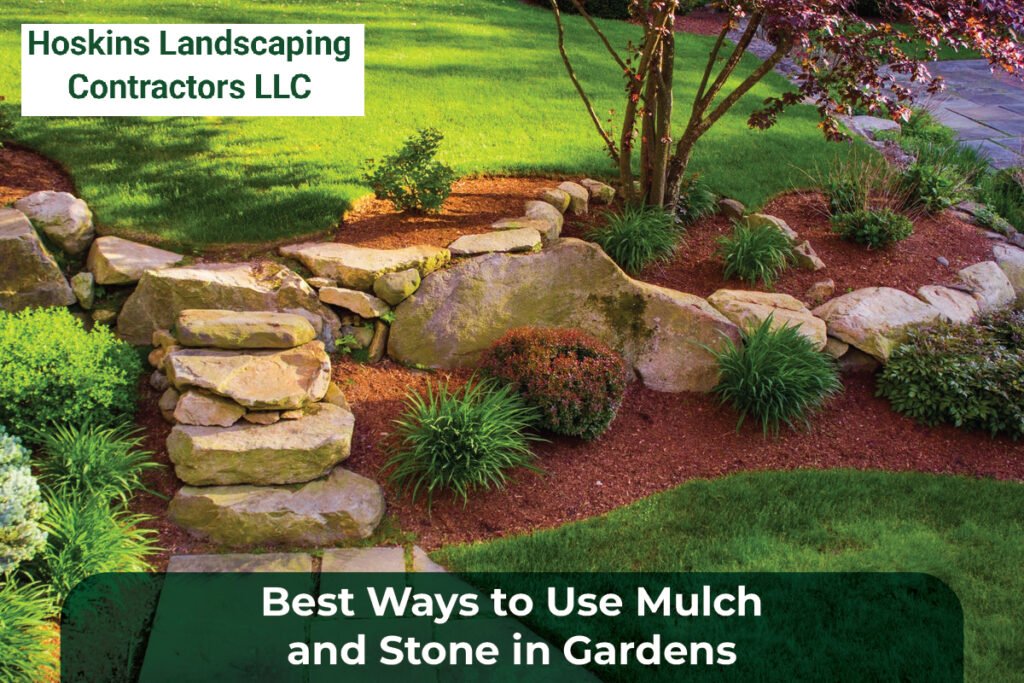When it comes to enhancing your garden’s appearance while promoting healthy plant growth, mulch and stone are among the most effective and versatile materials you can use. Whether you’re aiming for a low-maintenance landscape or trying to control weeds and retain soil moisture, combining mulch and stone allows you to achieve both function and beauty. In this blog, Hoskins Landscaping & Contractors will explore the best ways to use these materials, compare different mulch types, and help you decide what works best for your garden’s unique needs.
Why Mulch and Stone Matter in Garden Design
Before diving into techniques, it’s important to understand why mulch and stone are essential tools for any gardener.
Mulch serves multiple functions:
- Suppresses weed growth
- Retains moisture in the soil
- Moderate soil temperature
- Improves soil quality over time (organic types)
- Enhances garden aesthetics
However, stone is excellent for:
- Creating permanent, low-maintenance areas
- Improving drainage
- Defining garden borders
- Providing a decorative ground cover that lasts for years
The combination of mulch and stone allows you to tailor your garden for both performance and visual appeal.
1. Use stone and mulch to create defined zones.
Using mulch and stone together can help define specific zones in your garden. For example:
- Use garden mulch in planting beds for vegetables and flowers.
- Lay decorative stone around seating areas or pathways to create a clean, structured look.
By visually separating areas using these materials, your garden appears more organized and intentional.
2. Use Organic Mulch to Nourish Your Plants
Organic mulch is among the greatest kinds for garden beds and includes:
- Wood chips
- Shredded hardwood
- Bark mulch
These decompose gradually, adding nutrients to the soil. They are perfect for use in flower beds or vegetable gardens where soil health is a priority.
For example, bark mulch is great for perennials and shrubs, while shredded hardwood offers a dense layer that’s excellent at weed suppression and water retention.
3. Add Color and Contrast with Dyed Mulch
If you want your landscape to pop visually, consider using dyed mulch. Available in red, black, or brown, dyed mulch provides contrast against green foliage or light-colored stones.
- Warmer colors and brick homes go well with red mulch.
- Black mulch creates a sharp, modern contrast.
- The natural appearance of brown mulch goes well with most plant colors.
Use dyed mulch in high-visibility areas like front yard beds or borders for a polished look.
4. Use Playground Mulch for Safety and Function
If your garden includes a play area for children, consider playground mulch. It’s a softer, safer alternative made specifically to cushion falls. While not suited for all garden areas, it’s perfect under play structures and in family-friendly outdoor spaces.
5. Stone for Borders and Pathways
Stone is not just decorative—it’s also functional. Use landscape stone to:
- Outline flower beds
- Edge garden paths
- Build low retaining walls
- Create stepping stone paths
Pea gravel or crushed stone can be used as a base for walkways, while larger rocks or flagstones make excellent stepping paths.
6. Use Stone in Drainage Zones
Stone can aid in drainage if there are water-retaining areas in your yard. Install stone in low-lying spots to direct runoff or prevent pooling. Unlike mulch, which may wash away, stone remains in place and allows water to flow through effectively.
7. Keep It Clean: Rubber Mulch for Problem Areas
Rubber mulch can be a great alternative in areas where minimal maintenance is desired. It doesn’t decompose, won’t attract bugs, and requires almost no upkeep.
Use rubber mulch around trees, benches, or in playgrounds where longevity and cleanliness are key priorities.
8. Combine Mulch and Stone for Layered Effects
Design your garden beds with mulch and stone in combination. For instance:
- Use stone borders to frame a bed of shredded hardwood or dyed mulch.
- Place wood chips in inner areas and surround them with decorative gravel for a tidy contrast.
This keeps mulch in place, lowers runoff, and enhances aesthetics.
9. Refresh Mulch Annually
Even though mulch offers many benefits, it needs refreshing at least once a year. Organic mulch breaks down and becomes less effective with time. Keep the depth between two and three inches to guarantee moisture retention and weed suppression.
10. Use Mulch for Flower Beds Strategically
For flower gardens, use mulch to shield fragile blossoms and keep roots cool during the heat. Organic materials like bark mulch or shredded hardwood are ideal for flower beds, offering both nourishment and weed control without overwhelming the plants.
FAQs
Q1: What is the ideal mulch thickness for a garden bed?
A: Apply 2 to 3 inches of mulch. Over 4 inches could choke plant roots or keep water from penetrating the soil.
Q2: Can I use both mulch and stone in one garden?
A: Absolutely! Use mulch in plant areas and stone for paths or borders to create structure and contrast.
Q3: What is the best mulch for flower beds?
A: Organic mulches like bark, shredded hardwood, or dyed mulch are great for flower beds due to their ability to retain moisture and enrich the soil.
Q4: How long does mulch last?
A: Organic mulch usually lasts one year before needing a refresh. Stone can last indefinitely with minor maintenance.
Q5: Is rubber mulch safe for plants?
A: Rubber mulch is not ideal for plant health, as it doesn’t break down or enrich the soil, but it’s excellent for non-growing areas like playgrounds.
